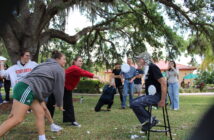
You finally squeeze in some time to call your parents, long distance best friend or significant other. Conversation is good, topics are flowing like usual and then it goes silent on the other end of the phone so you pull the phone away from your ear to see that you have “no signal” again. Why does this happen on campus so often? Is it the buildings or the small town environment? Actually, there are several factors that play into this.
What gives us cell phone reception? There are so many factors. Antennas and Networks are important for strong and good quality cell phone reception. According to the Federal Communication Commissions (FCC), these can be limited due to topography (surrounding), capacity (amount of callers communicating with the same cell site at a given time), and network architecture (where the antennas are located). An example of full capacity is if an individual makes a phone call and it gives the call a “busy signal”. An example of poor network architecture is when we drive into the campus parking garage; we could potentially lose signal and drop the call.
Roaming can cause a lack in receiving and sending out messages and calls. When a phone is roaming it means that it is only receiving calls from the same area, but no other areas.
After surveying students on their cell phone reception on campus, the results conclude that the average rating of student’s reception is a 2.75 out of 5 stars.
Most students have AT&T as their cell phone carrier. Coming in second place is a tie between Verizon Wireless and T-Mobile. Metro PCS, Boost Mobile and Sprint are the least popular on campus. Most students have an Apple. Androids follow Apple in popularity and then follow Droids. There is no correlation involving the cell phone reception received on campus based on the results. Regardless of the carrier and the type of cell phone, each person struggles with the cell phone reception on campus. The one thing all the results did have in common is that cell phone reception was lacking in all areas of campus. With that being said, it does not have anything to do with the carrier or type of phone. That brings us down to the cell phone towers in the area and the architecture.
According to Cell Reception, AT&T’s closest tower to campus is in Dade City; actually the closest cell phone tower to campus. T-Mobile’s closest cell phone tower is in Zephyrhills. Verizon’s closest cell phone tower is in Land O’ Lakes and Wesley Chapel. Sprint has the farthest cell phone tower from campus, which is in Plant City.
On the Wireless Coverage Complaint Database, in 2011, an AT&T user posted, “Extremely poor cell reception. Must seek “sweet spot” when making AT&T calls. Major concern, especially in time of emergency.” Nothing has changed with cell phone reception in Dade City.
The campus buildings are made out of cement blocks, which is a signal blocker in itself. The distant phone towers cause the poor cell phone reception from campus and the architecture of the buildings. University Technology Services is currently researching the cell phone reception on campus as well. They are doing their best to make any improvements possible.
According to Derek Hess in University Technology Services, the possible solutions to increase the success provided with cell phone reception is the follow: “Distributed Antennae System (DAS) is a deployment consisting of a cellular antennae on top of the most “signal worthy” building, or buildings, on campus. The signal is captured and then re-distributed through coax cable circuits to internal repeaters located strategically within the buildings.”
The second option given by Derek Hess is, “Another option is called Voice over Wi-Fi (VoWifi). We are very interested in this technology because it will allow users to leverage our existing Wi-Fi network (SLUNET). Sprint and T-Mobile have already enabled VoWifi on their platforms. It will only work on the most recent generations off Smartphones. We expect AT&T and Verizon to turn this feature on in the next few months (tentatively).”
So how do we make sure the phone we get will provide the best cell phone reception? One can research the cell phone towers close to their home or main location in which they will be using their phone. One can also consider the reason in which they are buying the cell phone. For example, one could be using it for long distance calls or for emergencies only. The best suggestion given by the FCC is to buy the cell phone that will meet the needs of its use.




